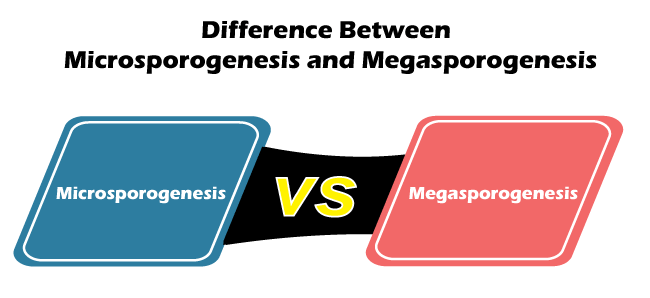Difference between Microsporogenesis and MegasporogenesisWe all have studied biology from classes 6th to 10th. Many of us go for further studies in biology too. Biology is a branch of science that deals with the human, plant, and animal cells. Several different and difficult terms in biology that focus on the plant cell or the animal cell. Out of these, microsporogenesis and megasporogenesis are the two terms that we will be discussing today. So, without further ado, let us begin with microsporogenesis. Microsporogenesis is defined as the process wherein small spores are formed among the seed plants. These spores are formed within pollen sacs of the plants. These pollen sacs are further transformed into the pollen grains that are dispersed when the plants reproduce. This dispersion of pollen grains helps in plant reproduction. Microsporogenesis is a process wherein the mother cell divides itself to form pollen grains. In this way, a four-wall structure is formed called nuclei. There are two kinds of microsporogenesis, i.e., simultaneous and successive microsporogenesis. 
In simultaneous microsporogenesis, the process of meiosis takes place. Meiosis is defined as the cell division of the daughter cells having half of the parent cell's chromosomes present in gametes and plants. In the simultaneous process, cytokinesis takes place through the process of meiosis. As a result, there is a formation of four cell walls between the nuclei. This kind of formation is widely seen in dicotyledons. On the other hand, in the successive microsporogenesis, cytokinesis is formed twice, i.e., at the end of meiosis I (formation of two cells) and meiosis II (formation of four cells). This kind of structure and formation is found in monocotyledons. As far as cell formation is concerned, there are five kinds of tetrads in which the cells are formed. These forms are tetrahedral, decussate (intersection formation), isobilateral (identical formation on all the walls), linear (arranged in a straight line), and T-Shaped. Among all of these shapes, tetrahedral is one of the most important and common shapes during cell formation. It is interesting to know that the microspore is considered the first cell of the male gametophyte. The male gametophyte is unicellular, and the shape varies indistinctively. Inside the male gametophytes, there are thousands of pollen grains. The wall that covers these pollen grains is known as sporoderm. Sporoderm is divided or made of two layers, wherein the outer layer is called exine, and the inner layer is called intine. Exine in plants is the most rigid substance capable of handling heat, pressure, alkali, etc. On the other hand, the inner layer is thin and comes out at the time of pollination or germination. The cytoplasms of the pollen grains are abundant in nutrients. Microsporogenesis is one of the important processes in plant germination. This process helps in plant reproduction that includes plant development from cell walls to microspores. Haploid microspores are the end product of microsporogenesis. Haploid microspores are the formation of cell walls and pollen grains in a linear form. So, this was some important information on microsporogenesis. Microsporogenesis helps in plant reproduction and germination by dispersing the pollen sacs. Thus, this process helps in the pollination of plants, flowers, etc. Having discussed some points about microsporogenesis, let us now discuss some information regarding megasporogenesis. Megasporogenesis is the process wherein the development of megaspores takes place. The megaspores are developed from megasporocyte. Megasporocyte is a kind of cell that undergoes the process of meiosis. And like in microsporogenesis, meiosis also helps in the formation of haploid megaspore. The process in which the four megaspore cells are formed is called monosporic megasporogenesis. In this process, one wall is dedicated to the formation of the female gametophyte. In layman's terms, megasporogenesis is defined as the process of developing the megaspores through meiosis. This process is like microsporogenesis, but both have varied differences. Megaspore is a generally larger spore that helps in the germination of the female gametophyte. Female gametophyte helps in producing egg cells that further result in plant reproduction. Megaspores are found in heterosporous plants. Now, heterosporous plants are defined as plants having different sizes and different sexes. Heterosporous plants have the following things:
It is interesting to note that, in plants, the megaspore is produced inside the ovule. During the megasporogenesis process, the mother cell undergoes the process of meiosis. Through the process of meiosis, the haploid cells are formed. The flowering plants, also known as angiosperms, include three kinds of megasporogenesis, i.e., bisporic, monosporic, and tetrasporic. Monosporic megasporogenesis is one of the important types of process. This process is majorly found in Gramineae (rice, wheat, etc.), Malvaceae (cotton), Solanaceae (tomato, potato, pepper, etc.). The bisporic pattern includes cell formation through the process of meiosis I. This results in the production of two nuclei megaspores, out of which one degenerates. The tetrasporic process is defined as the process wherein the cells fail even after undergoing meiosis I and II. This process results in the production of four nuclei megaspores. So, these are some key points regarding megasporogenesis. This process is somewhat like microsporogenesis, but there are certain differences added to it. So, let us see some key differences regarding the two of them.
So, these are some of the key differences regarding microsporogenesis and megasporogenesis. Both are different in their structure and arrangement. But they both help in the pollination and germination of the plant cells. Both the processes are required for plant reproduction. Thus, both microsporogenesis and megasporogenesis are important for dispersing the pollen sacs that result in plant germination.
Next TopicDifference between
|
 For Videos Join Our Youtube Channel: Join Now
For Videos Join Our Youtube Channel: Join Now
Feedback
- Send your Feedback to [email protected]
Help Others, Please Share










